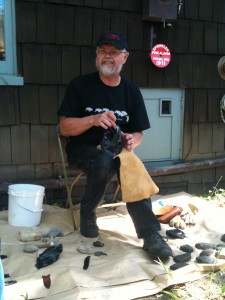Yesterday I attended a delightful session at the Hillside Club on flintknapping, the process of making stone tools, with Dr Bruce Bradley. Far from just a technical demonstration about how to make knives out of rocks, it was a fascinating conversation about anthropology and ancient cultures before the invention of metallurgy.

First we watched Bruce’s 1988 video Flintknapping, where he makes four tools from a single piece of obsidian. I first thought he meant four individual finished obsidian tools, but in fact he meant four successive tools from the same piece of obsidian. Assuming that an archaic Native American hunter has just killed a bison, Bruce first made a knife with which to skin the bison. After the skinning process is finished, Bruce then reformed the skinning knife into a rougher, serrated tool for separating the meat from the bones. Once the meat has been removed, Bruce worked the tool into a thin knife for slicing the meat into strips (in order to dry and smoke the meat for preservation). The fourth and last tool in the sequence is a spearhead to attach to the spear so that the hunter is armed for the home journey (and because the hunter’s original spearhead was probably damaged when he killed the bison). Thus, what starts out as a large skinning knife ends up as a spearhead less than half the size.

After the video, we all moved outside to watch Bruce create a “Buchanan Eared arrowhead”, which was the type made by the local Ohlone tribes. During his work, Bruce happily answered many questions, such as:
- Is it possible to tell whether the maker of a given piece was right-handed or left-handed? Some people think so. It’s still a matter of discussion.
- Do you ever find student-made pieces in an archaeological setting, as if it were an ancient classroom? Yes! There is a site in France where tools were dug up along with all the flakes from that tool’s production. By carefully piecing all the flakes together, the researchers were able to rebuild the original nodule and demonstrate the skill (or lack of it) as the piece was shaped. In several instances, they were able to show an beginner knapper who got stuck at a particular place, followed by a few expert strokes by the teacher to show the student how to fix the problem, followed by more novice clunking.
- Do you agree with the hypothesis that the development of knapping technology went hand-in-hand with the development of human language? Lots of work is being done in this area. One researcher conducted two sets of training sessions with brand-new knapping students: one using standard English, and the other using no spoken words at all—only hand signals. He found that the ‘mute’ group could only progress so far: there existed situations where gestures could not help the students solve the problem at hand.
- Are there many modern arrowheads on the market being represented as old authentic ones? Yes indeed, very many. Experts can generally tell them apart, but be extremely careful if you’re buying ancient artifacts.